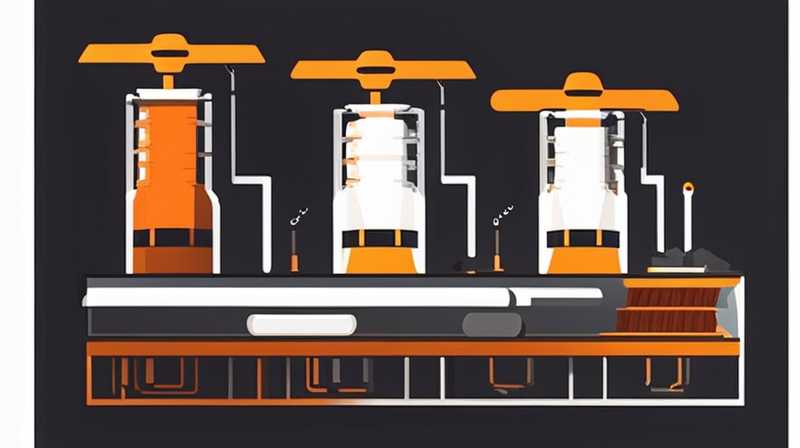
To address the issue of a rusted solar tank, it is vital to take a series of appropriate measures to restore functionality and extend its lifespan. 1. Identify the source of rust, 2. Assess the extent of damage, 3. Clean the tank thoroughly, 4. Apply rust prevention methods. Particularly, recognizing how rust develops can assist in preventing future occurrences. Over time, oxidation can lead to severe deterioration, particularly in environments prone to moisture. This evaluation process will inform necessary repairs or replacements, ensuring that the solar water heating system operates efficiently.
- IDENTIFYING THE SOURCE OF RUST
A pivotal aspect involves recognizing the origination of rust within the solar tank. Rust primarily occurs as a consequence of prolonged exposure to moisture combined with other environmental factors. Metal tanks are inherently susceptible to oxidation when water accumulates, either through leaks or external exposure to rain. Understanding contributing factors is crucial, as it aids in developing an actionable plan to rectify the problem. For instance, if leaks in joints or connections are detected, sealing these points may significantly reduce future corrosion risks.
Furthermore, utilization of inferior quality materials can lead to accelerated rust development. Stainless steel is often touted for its corrosion-resistant properties, yet not all stainless steel grades are created equal. Some may still succumb to rust under certain conditions, especially if they are exposed to prolonged moisture or aggressive environments. Thus, conducting an investigation into the tank’s material composition can illuminate the best prevention measures moving forward.
- ASSESSING THE EXTENT OF DAMAGE
Once the source of rust has been located, the next step necessitates evaluating the severity of the damage. This critical assessment typically involves a combination of visual inspections and tactile examinations of the tank’s surface. Continuous observation can unearth minor rust spots that may signal larger underlying issues. A superficial examination may overlook significant structural deterioration which could compromise the entire system.
Additionally, employing diagnostic tools like ultrasonic thickness gauges can provide more detailed insights into metal loss due to rust. These instruments offer precise measurements that can guide decision-making whether to repair or replace the tank entirely. This data-driven approach eliminates guesswork, ensuring resources are allocated wisely.
- CLEANING THE TANK THOROUGHLY
A cardinal step in remediation is performing a meticulous cleaning ritual. Before delving into any repairs, eliminating all rust from surfaces is paramount. This process often entails utilizing wire brushes, scrapers, or sanders to eradicate loose rust particles effectively. Safety precautions must be observed to prevent inhalation of rust dust or debris, which could pose health risks.
In addition to mechanical cleaning, employing chemical agents can further facilitate the de-rusting process. Products rich in phosphoric acid can convert rust into a stable compound that prevents further deterioration. Applying these chemicals requires adherence to safety protocols and manufacturer instructions. A well-executed cleaning strategy lays the groundwork for applying protective coatings afterward, ultimately extending the tank’s longevity.
- APPLYING RUST PREVENTION METHODS
Following the restoration of the tank’s surface, implementing effective rust prevention strategies becomes integral. One common approach involves applying rust-proofing paint or sealants designed specifically for use on metal surfaces exposed to moisture. These advanced formulations serve to create an impermeable barrier, thereby inhibiting moisture intrusion and oxidation.
Additionally, considering the use of cathodic protection can be an effective long-term solution. This technique employs a sacrificial anode, typically made from zinc or magnesium, to corrode instead of the tank. The installation of these anodes will reduce the rate at which the solar tank succumbs to rust. Regular inspection of the anodes is also essential, as they should be replaced once they are significantly corroded.
- FREQUENTLY ASKED QUESTIONS
RUST IN SOLAR TANKS: IS IT COMMON?
It’s not unusual for solar tanks, particularly those constructed from metal, to exhibit signs of rust over time. Environmental factors, alongside the quality of materials and installation methods, play pivotal roles in the likelihood of rust development. Some regions prone to humidity and moisture accumulation witness higher occurrences of rust issues. Therefore, regular inspections can significantly enhance early detection, preventing extensive damage while ensuring the longevity of the solar system.
HOW CAN I PREVENT FUTURE RUST IN MY SOLAR TANK?
To mitigate the risk of rust reappearing, several key practices can be adopted. Investing in high-quality materials, especially those rated for corrosion resistance, is a wise choice. Furthermore, proper installation and sealing of joints and connections prevent moisture ingress. Implementing regular maintenance checks, including cleaning and inspecting the tank for rust or leaks, can help catch minor issues early before they evolve into significant concerns. Finally, applying protective coatings as described can greatly reduce moisture exposure over time.
WHEN SHOULD I REPLACE MY SOLAR TANK?
Determining the need for replacement varies based on several aspects. If extensive rust damage is evident, contributing to leaks or loss of efficiency, replacement may be the more economical and practical solution. Additionally, if repairs exceed a certain percentage of the tank’s value, investing in a new tank becomes advisable. Customers should consider factors such as warranty coverage, age of the tank, and overall performance before reaching a decision. Consulting a qualified technician can provide clarity and guidance on this matter.
In conclusion, tackling the dilemma of a rusted solar tank requires methodical actions and a comprehensive understanding of the underlying issues at play. Initially, identifying the source of rust constitutes a foundational step. A meticulous assessment of the extent of damage follows, serving to guide subsequent actions. Cleaning the tank with precision lays the groundwork for applying effective rust prevention methods. These protocols and strategies provide assurance against recurring rust problems, ultimately preserving the efficiency and performance of the solar system. Regular maintenance and attention to detail must be prioritized to prolong the tank’s lifespan and efficacy. By safeguarding against rust, homeowners not only protect their investment but also contribute to sustainable energy practices, promoting the overall health of their solar water heating systems for years to come.
Original article by NenPower, If reposted, please credit the source: https://nenpower.com/blog/what-to-do-if-the-solar-tank-is-rusted-2/

